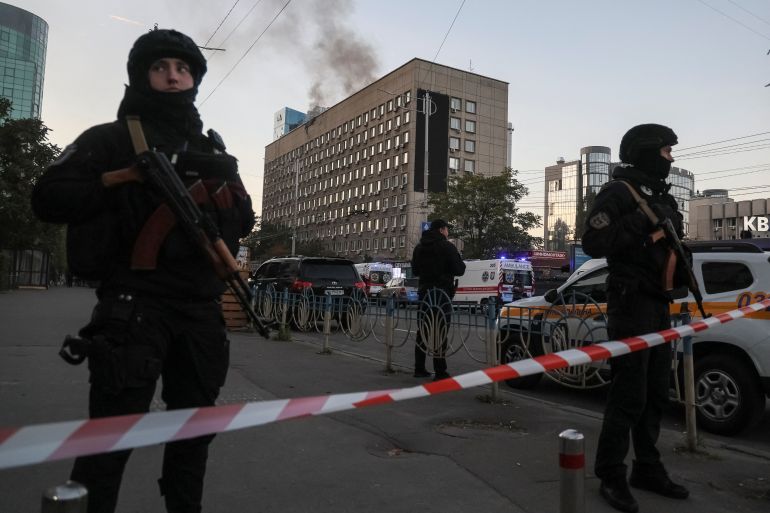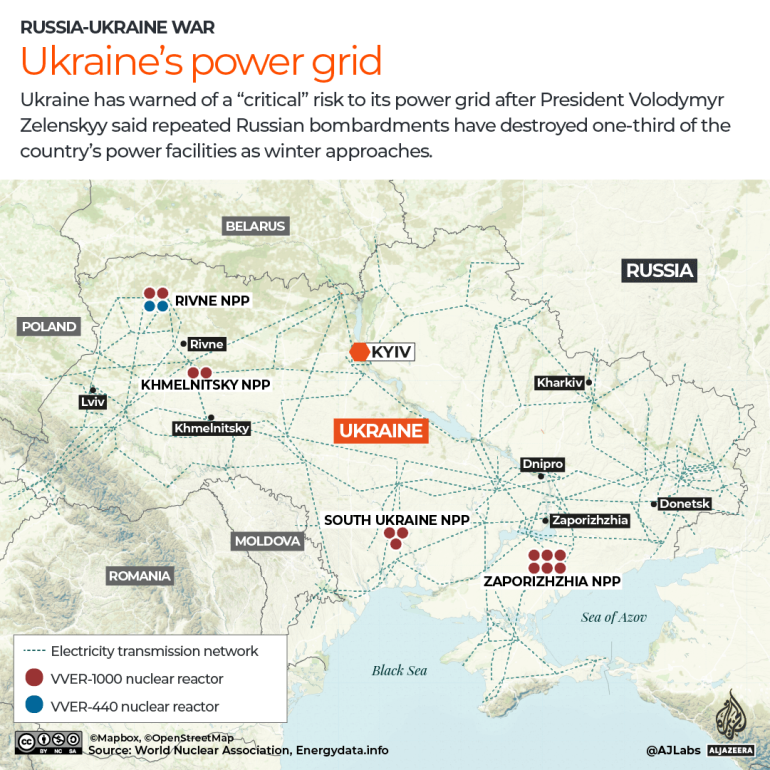New wave of Russian air raids hits Ukrainian cities, energy sites
Ukraine’s allies promise to send more air defence systems and missiles to Kyiv as Russia renews aerial attacks.

Russia pounded Ukrainian cities and energy infrastructure with missiles and “kamikaze” drones during the 34th week of the war, killing dozens of people and leaving several towns without power.
President Volodymyr Zelenskyy said on Tuesday that 30 percent of Ukraine’s power stations had been destroyed in drone attacks since October 10, leading to “massive blackouts” across the country. He urged Ukrainians to use less electricity during the evenings.
Keep reading
list of 3 itemsPutin declares martial law in annexed regions of Ukraine
Ukraine says threat to power grid ‘critical’ amid Russian attacks
Four people were killed when a drone hit a residential building in Kyiv on Monday, the mayor said. Vitali Klitschko said Russia launched 28 drones during the attack and five explosions were heard in the city.
Ukrainian authorities say the drones are Iranian-made, and they have urged Tehran to stop supplying them to Russia. Iran has denied supplying the drones, and Russia has not commented. Moscow denies targeting civilians.
Ukrainian foreign minister Dmytro Kuleba called on the EU to impose sanctions on Iran.
“In the last week alone, the Russian Federation has struck through more than a hundred Iranian kamikaze drones against residential buildings, power stations, sewage treatment plants, bridges and playgrounds in a number of Ukrainian cities,” he said on Monday. “Dozens of people, including children, were killed and injured. We call on Tehran to immediately stop supplying Russia with any weapons.”

Ukraine’s air force says it shot down 223 of the unmanned aircraft since they first appeared in the country on September 13.
Ukrainian defence minister Oleksiy Reznikov estimated Russia still has a stockpile of about 300 of the drones and plans to buy “several thousand” more.
Ukraine has accused Russia of increasing its use of the drones as its precision missile stocks run low. Reznikov published stockpile figures suggesting Russia has fired two-thirds of its most sophisticated missiles at Ukraine and has about 600 left.
According to United States intelligence, Russia has also been buying artillery shells from North Korea to replenish its dwindling stocks.
Outrage and demands for help
The Russian aerial campaign prompted Estonia’s parliament to declare Russia a “terrorist state”. European Commission President Ursula von der Leyen called the attacks on Ukrainian infrastructure “war crimes”.
The hail of destruction on Ukraine’s cities also speeded up delivery of air defence systems and kindled new pledges of weapons deliveries from allies.
Air force spokesman Yuri Ignat said the IRIS-T air defence system supplied by Germany had already been integrated into Ukraine’s air defences and was operational.
Reznikov said the first National Advanced Surface-to-Air Missile Systems (NASAMS) promised by the US would arrive in Ukraine this month.
The United Kingdom said it will send Ukraine hundreds of AMRAAM missiles for the US launchers while France promised Ukraine Crotale short-range, low-altitude air defence systems, which are effective against aircraft and missiles.
US President Joe Biden announced a new delivery of weapons worth $725m. The package includes vehicles and ammunition, including for HIMARS multiple rocket launchers.
Ukraine and its allies also began to look at more comprehensive and long-term air defence solutions.
The chairman of the US Joint Chiefs of Staff, Mark Milley, said the US was looking into creating integrated air defence systems for specific areas of Ukraine, including short-, medium- and long-range air defence systems. “The combination of all these means will allow us to close the airspace for Russian aircraft,” Milley said.
Yuryi Zozulya, an advisor to Kyiv’s mayor, said British and Canadian scientists were working on a protective dome to keep drones away from Ukraine’s capital. It would take about two years to complete but sections of it were already operational, he said.
Russian narratives
Russia escalated its targeting of cities throughout Ukraine after the October 8 bombing of the Kerch Bridge, which connects Ukraine’s occupied Crimean Peninsula with Russia.
Maxim Alyukov, a research fellow at the Russia Institute at King’s College London, told Al Jazeera that the attack on the bridge, a symbol of Russian prestige, influenced President Vladimir Putin to go along with the demands of Russian nationalists and hardliners.
“Pro-war communities and military reporters on Telegram and, to some extent, hosts and participants on political talk shows got very angry,” Alyukov said. “And while they were radical even before, pushing the government to announce a mobilisation and even to use nuclear weapons after the Kerch Bridge was attacked, on state TV, there was a narrative used that … ‘we are very humane and don’t target civilian infrastructure and power plants, and we should probably reconsider our strategy.’ After the Kerch Bridge, they started saying, ‘Now we are engaging fully.’”
Alyukov says civic or civilian infrastructure is presented as critical to Ukraine’s war effort to justify it being targeted by Russia.
“Media used certain terms even before the current attack on Kyiv – ‘critical infrastructure’ and ‘decision-making centres’, meaning administrative buildings like parliament, government, security services, etc,” Alyukov said.
“Now [after the Kerch Bridge attack], they use these terms to mean that this infrastructure is critical for the Ukrainian war effort,” he said. “They try to avoid using the word civilian.”
Preparations for Kherson evacuations
On the ground, Russian forces made little progress during the 34th week of the war. The main area where Russian forces remained consistently on the offensive was around Bakhmut in the Donetsk region, where Wagner Group mercenaries are reported to be heavily involved in the fighting.
Russian forces have been trying to capture the eastern transport hub for months. Fighting there has been relentless. Ukraine’s defence ministry published a few seconds of video from the battlefields around Bakhmut showing a scene of trenches amid pockmarked red earth and splintered bare trees.
“There are very complex, heavy battles going on there, [where] the enemy concentrated his most powerful forces,” said Serhiy Cherevaty, spokesman for Ukraine’s eastern forces.
In Kherson in the south and Kharkiv in the north, Russian forces have been trying to hold off Ukrainian offensives since August.
Russia’s Tass news agency reported that Russian defenders prevented Ukrainian forces from crossing the Zherebets river in the area of Stelmakhovka and Makeevka as they try to advance on Svatove in the Luhansk region.
Russia also said it had repulsed a Ukrainian attack on Bruskinskoye, Koshara and Piatykhatky on the west bank of the Dnipro River in Kherson.
Local Russian officials spoke in defensive tones. “Our army is ready to repel all these attacks, to stand to the end since the Kherson region is a full-fledged subject of the Russian Federation,” said Kirill Stremousov, deputy governor of the Russian-installed administration in Kherson.
Kherson is one of four Ukrainian regions that Russia unilaterally annexed on September 30 despite only partially controlling them.
Moscow is preparing to help residents of the occupied portion of Kherson evacuate to Russia in a sign that its grip on the territory is weakening.
Zelenskyy said Ukraine’s armed forces have recaptured 1,620 settlements nationwide since the beginning of the war.